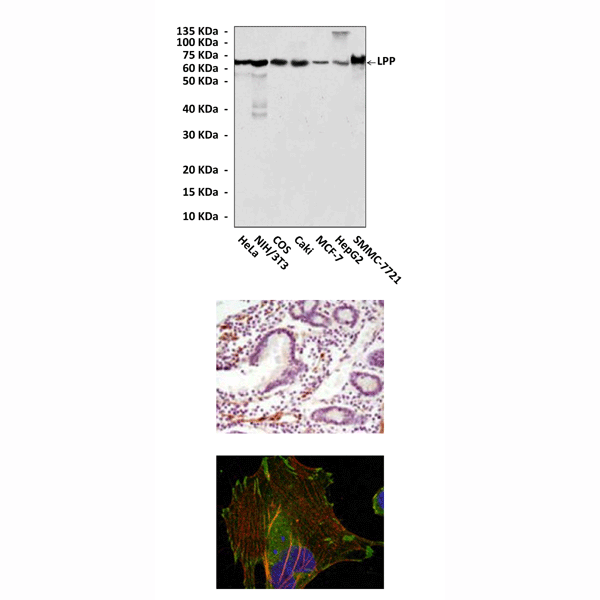Anti-LPP: Mouse LPP Antibody |
 |
BACKGROUND The LPP (LIM domain containing preferred translocation partner in lipoma) gene was previously identified as the most frequent translocation partner of HMGA2 (High Mobility Group A2) in a subgroup of benign tumors of adipose tissue, i.e. lipomas with an aberration involving chromosome segment 12q15 harboring the HMGA2 gene. In the years after its discovery, LPP was also shown to be rearranged in a number of other soft tissue tumors, as well as in a case of acute monoblastic leukemia. In addition to its involvement in tumors, two independent laboratories identified LPP as a novel smooth muscle cell (SMC) marker and, in a recent follow-up study; LPP was shown to regulate SMC migration in vitro.1
LPP is a member of the zyxin family of proteins, whose structure is characterized by the presence of multiple protein–protein interaction domains including C-terminally located LIM domains. LPP localizes in focal adhesions, which are sites of membrane attachment to the extracellular matrix, and in cell–cell contacts. It is able to interact with VASP (vasodilator-stimulated phosphoprotein) and alpha-actinin, both of which localize at cell adhesion sites.2 Recently, palladin, an actin associated protein, was found to bind LPP and both proteins were shown to play an active role in the adhesion turnover of migrating SMCs. Another known interaction partner of LPP in human is SCRIB, a functional homologue of the Drosophila tumor suppressor Scribble, which resides in cell–cell contacts, and is involved in the control of cell adhesion, cell shape and cell polarity. Scrib is implicated in the regulation of planar cell polarity (PCP) in vertebrates. The PCP pathway refers to a conserved signaling pathway that regulates the coordinated movements and polarity of cells or structures within the plane of an epithelium.3
Of interest to note is that LPP is also able to shuttle to the nucleus. LPP has been shown to possess a Crm1-dependent nuclear export signal. LPP has also been shown to possess two domains harboring transcriptional activation capacity, which coincide with the LIM domains and the proline-rich region preceding these. These observations suggest that LPP might have a role in regulating gene expression in the nucleus, where it acts as a coactivator of the ETS-domain transcription factor PEA3.4 PEA3 activates gene expression and is thought to play an important role in promoting tumor metastasis but also in controlling neuronal development, including neuronal path finding. LPP also showed capability to activate a reporter gene expression in a GAL4-transactivation assay in cells, and it has been suggested that LPP belongs to a new family of proteins which communicate between the cell surface and the nucleus.
REFERENCES
1. Gorenne, I. et al: Circulat. Res. 98:378-85, 2006
2. Hansen, M.D.H. & Beckerle, M.C. : Biochem Biophys Res Commun. 371:144–148, 2008
3. Vervenne, H.B.V.K. et al: Dev. Biol. 320:267-77, 2008
4. Guo, B. et al: Mol Cell Biol. 26: 4529–4538, 2006
2. Hansen, M.D.H. & Beckerle, M.C. : Biochem Biophys Res Commun. 371:144–148, 2008
3. Vervenne, H.B.V.K. et al: Dev. Biol. 320:267-77, 2008
4. Guo, B. et al: Mol Cell Biol. 26: 4529–4538, 2006
Products are for research use only. They are not intended for human, animal, or diagnostic applications.
Параметры
Cat.No.: | CP10155 |
Antigen: | Purified recombinant human LPP fragments expressed in E. coli. |
Isotype: | Mouse IgG1 |
Species & predicted species cross- reactivity ( ): | Human, Mouse, Rat |
Applications & Suggested starting dilutions:* | WB 1:1000 IP n/d IHC 1:200 ICC 1:200 FACS n/d |
Predicted Molecular Weight of protein: | 66 kDa |
Specificity/Sensitivity: | Detects endogenous LPP proteins without cross-reactivity with other family members. |
Storage: | Store at -20°C, 4°C for frequent use. Avoid repeated freeze-thaw cycles. |
*Optimal working dilutions must be determined by end user.
Документы
Информация представлена исключительно в ознакомительных целях и ни при каких условиях не является публичной офертой








